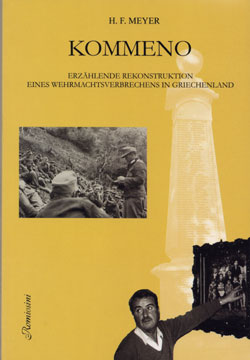 |
 |
 |
 |
 |
 |
 |
 |
||||||||||
|
|
|||||||||||||||||
Mousiotitsas, Kommeno und Lyngiades Tagesbefehl |
Kommeno. A narrative reconstruction of a war crime committed by the Wehrmacht in Greece
The 1. Gebirgs (Mountain)-Division [1. GD] was transferred from the Caucasus to Epirus in the middle of July 1943 within the strategy of amassing troops to repel an expected allied invasion in Greece. The Italian occupying army was being so hassled by the partisans that they only were left in control of a few strategic points and larger towns. The commander of the Italian 9th Army, D’Almazzo, recommended to the German commander of the 1. GD von Stettner that “all male inhabitants should be arrested” as he considered them all to be "bandits". This was the only way to bring peace to the area. Although this radical proposal was not pursued, the Germans immediatedly introduced procedures to “cleanse” the main road between Ioannina and Preveza and all the adjacent villages. The partisans’ hit and run tactics avoided major clashes with the Germans, but dozens of villages were set on fire in the following weeks. Hundreds of civilians were killed. The height of the terror was the massacre and annihilation of Mousiotitsas, Kommeno und Lingiades (German text. However, pictures carry english subtitles), as the attached article describes. One hundred and fifty-three men, women and children between the ages of one to seventy-five were butchered in Mousiotitsas on July 25th because of the discovery of a cache of weapons near the village. Regiment commander Josef Salminger saw a partisan’s machine gun while on an inspection trip through Kommeno. As a so-called reprisal the village was shelled on August 16th. It was taken without any resistance, as there were no freedom fighters there. The mountain troops then murdered any one who could not flee: 317 people, 172 women and 145 men were killed. Ninety-seven were under fifteen years of age and fourteen were over sixty-five. Thirteen were only one year old. Thirty-eight people were burnt in their houses. One hundred and eighty-one houses were destroyed. Sadistic excess fired the killing fever, according to statements by survivors but also by members of the regiment. When Salminger was murdered by partisans on October 1st, Hubert Lanz, commander of the XXII Gebirgsarmee-Korps, issued a Tagesbefehl, (order of the day/ German text) to avenge the death of his friend and leader of the regiment and called for a “ruthless retaliatory action”. Over 200 people were massacred. Among them were all those inhabitants of Lingiades who had not fled to the mountains. In this single village 87 civilians were killed, including year-old babies and old people over the age of ninety. The actions of the 1st Mountain Division in Epirus led after the war to a series of preliminary proceedings against those responsible but no charges were ever preferred because no witnesses in Greece were questioned nor were the statements of the perpetrators ever verified. In his book, the author goes into the detail of the inquiries and the witness statements. The book is available in bookshops or can be ordered direct from Romiosini (http://www.unisolo.de/pls/romiosini/griechische_literatur). The journal Thetis is available through www.rutzen-verlag.de |
||||||||||||||||
|
|||||||||||||||||








